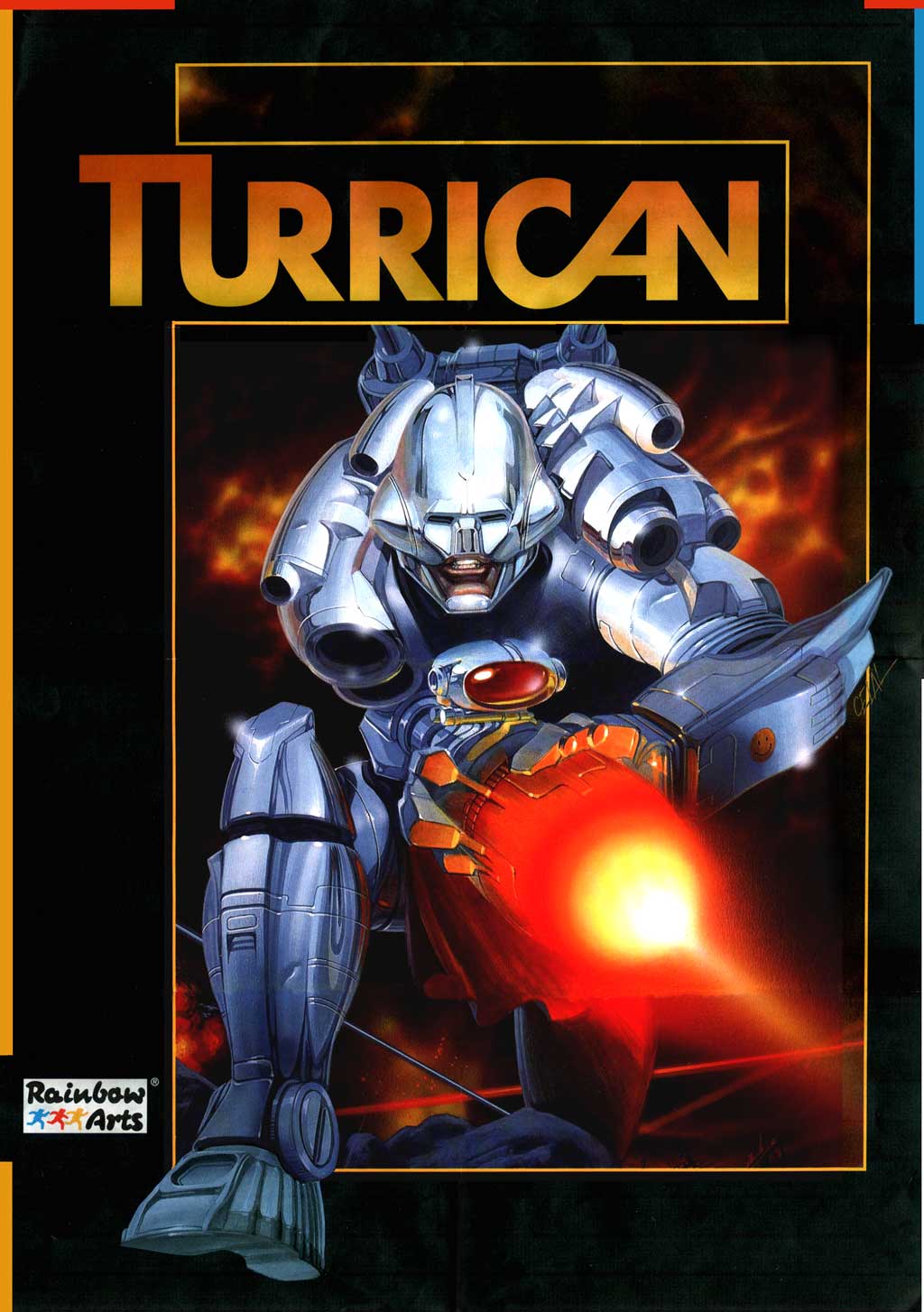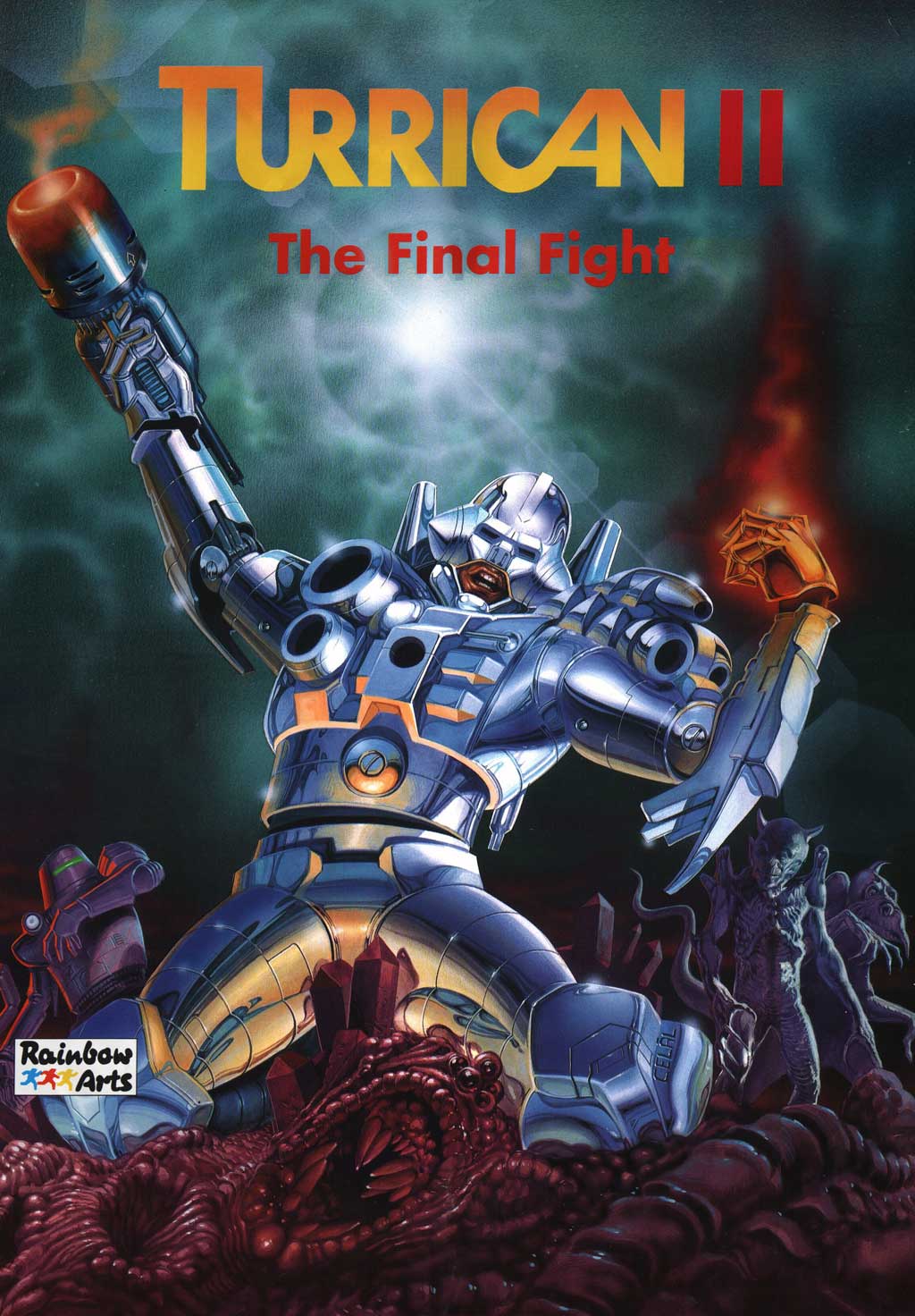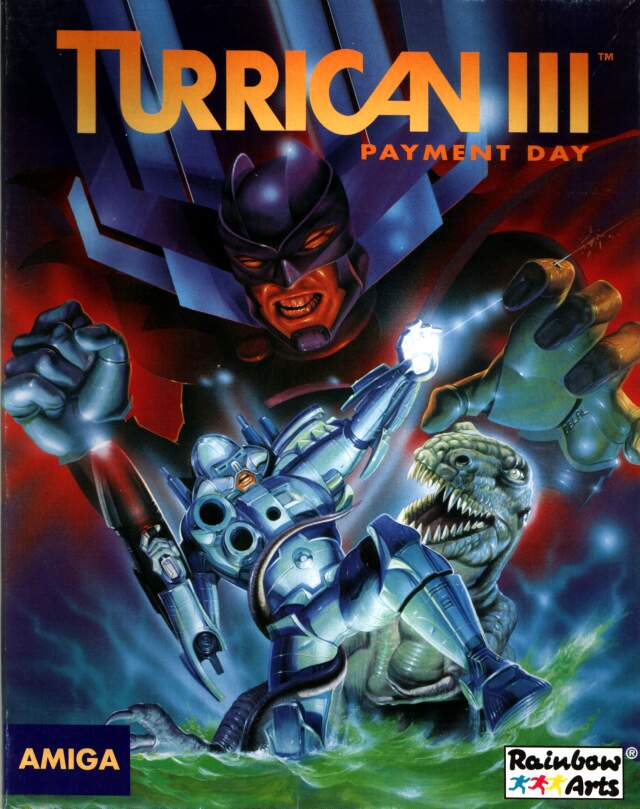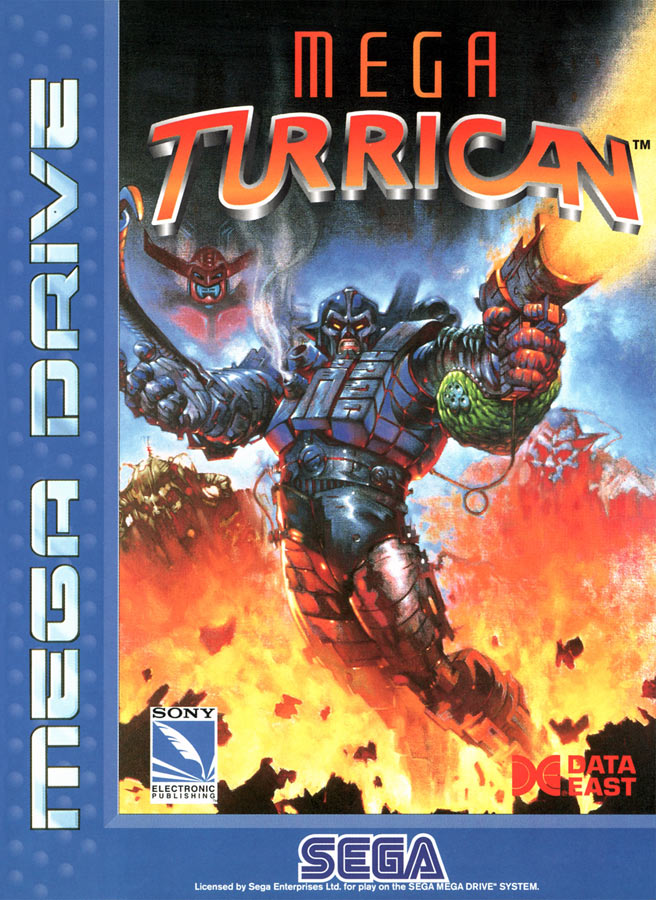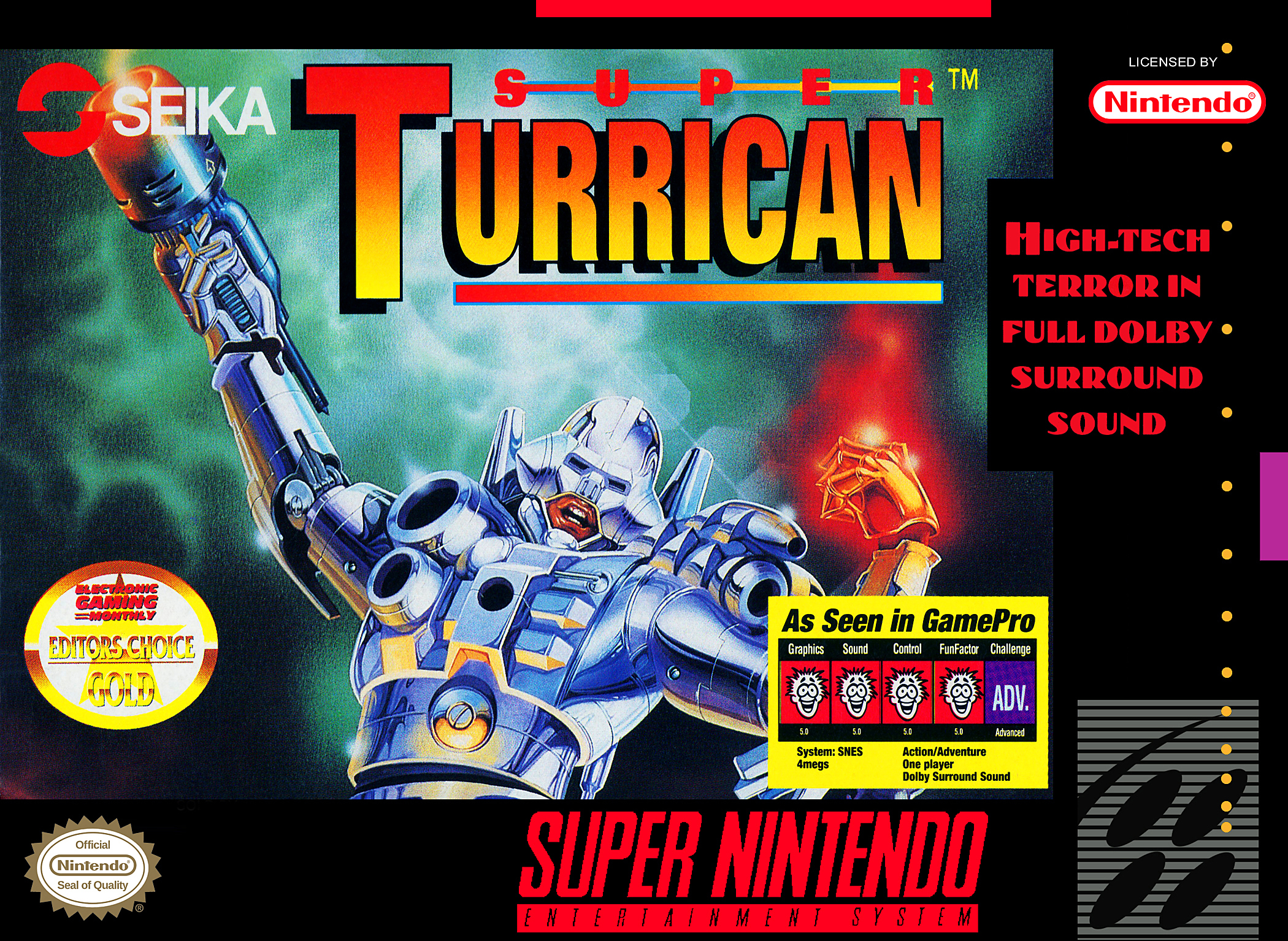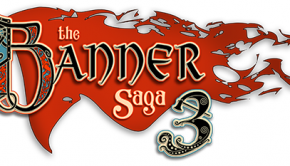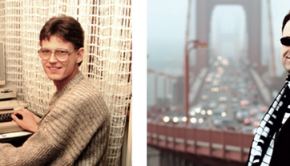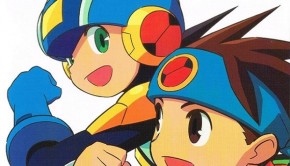Turrican Soundtrack Anthology Original Sound Version
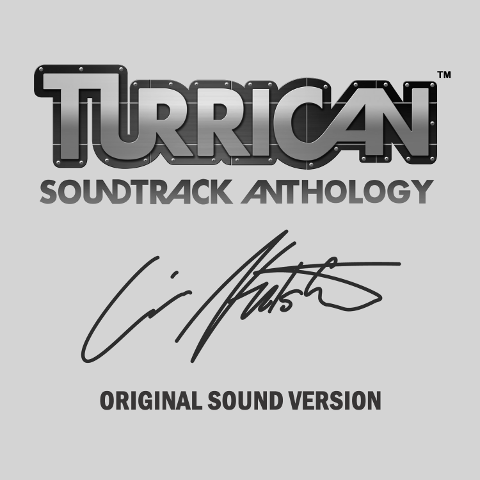 |
Album Title: Turrican Soundtrack Anthology Original Sound Version |
| Record Label: Chris Huelsbeck Productions |
|
| Catalog No.: N/A |
|
| Release Date: December 31, 2013 |
|
| Purchase: Download at Bandcamp |
Overview
When I asked to reviews of the Turrican soundtracks, I was completely oblivious to the series. I had already known who Chris Hülsbeck was due to his highly esteemed status in the video game music industry, but had unfortunately not seriously listened to his work. So in preparation, I found a good Amiga emulator and a ROM of the original Turrican. From the moment I booted up the game, I didn’t need to ask any more questions. THIS was Turrican and only one word could describe the sum of its parts: awesome.
In fairness, ignorance to this series was not really of my own fault. While hugely popular in Europe, Turrican has unfortunately never had a real audience in North America. For starters, it was originally released for the Commodore 64 in 1990. While this computer had some success in American markets with its library of games, the system was for the most part over-shadowed by the much cheaper and more popular NES home console. In Europe though, the personal computer market was earning considerably higher success. At this time, German programmer Manfred Trenz had three titles under his belt before he went on to create his masterpiece Turrican. The game pushed the Commodore 64 to its limits, ushering in then-high quality graphics that many did not believe possible for the system. Even the concept of putting a side-scrolling platformer on a PC was an extremely difficult undertaking due to most computers having restrictive memory limitations. But Trenz put the naysayers to rest by releasing his mega-hit Turrican, a non-linear shoot em’ up game akin to a mash-up of Contra and Metroid with a dash of Mega Man. At a time when practically all platformers were Japanese-made by the likes of Shigeru Miyamoto, Manfred Trenz proved to the world that Westerners could create quality titles that in some ways even surpassed the Eastern giants.
Arguably the best aspect of this series has been its addicting soundtrack by Chris Hülsbeck. Oddly enough though, the original C64 release of Turrican did not even have actual music! That did not come until the Amiga port which featured richer 16-bit graphics and improved gameplay mechanics. The composer worked with the Amiga’s limited sound system to create an epic score that rivaled the works of anything else currently available. Over the years there were many demands for a complete release of the soundtrack, but to no avail. Apart from a single remix album sold exclusively for the European market in 1993, Turrican was not given a dedicated album release. However in 2013, Hülsbeck launched a groundbreaking Kickstarter campaign in the hopes of raising the funds to create a high quality remix anthology release of music from the series. A large success going well over its intended goal, it demonstrated the devotion of the video game music community in supporting industry artists. Certain backers received a variety of “rewards” for donating, specifically a USB flash drive containing the full scores to Turrican, Turrican II, Turrican III, Super Turrican, Mega Turrican, and Super Turrican 2. The Original Sound Version was later re-released commercially through Bandcamp in two volumes. This article is specifically a review of the two digital volumes of the Original Sound Version, with the remix anthology to be covered later. Nearly a quarter century after its original game release, can the music to the Turrican series still hold up after all this time?
Body
Turrican
The legendary Hülsbeck score that started it all. Utilizing the Amiga in ways never before seen, hearing Turrican’s soundtrack now remains a richly satisfying experience. The synth is so good, it’s nearly on par with the modern chiptune albums that are being released today. Unlike most contemporary game scores of the time which only contained short 60 second loops of music, Hülsbeck goes all out with tracks that run well over four minutes.
Following an ominous cry of “Welcome to Turrican!,” things kick off with “Shoot or Die.” The fast-paced run-and-gun baseline accompanies players as they explore the huge area for the first time while a heroic techno melody provides the main meat. It would go on to be a serious staple, its memorable theme appearing in every future entry.
What I most enjoyed about Turrican’s score in particular is how each track flows perfectly into the next without sounding too samey. “Mountain Madness,” like its title, is a perfectly crafted techno piece with orchestral elements that fits with a character ascending to the peak while hoarding off swarms of enemies. Its melody is one of the more memorable ones on this album, and will stay with listeners long after the power is shut off. Hülsbeck demonstrates his darker style with pieces like “Outpost” and “Enemy Mine.” The former benefits from low octave bass with an industrial-beat melody. The later utilizes haunting choral synth that’s not unlike the ones heard in the acclaimed SNES platformer Super Metroid. Ironically though, Hülsbeck beat Nintendo to the punch four years before that title even was released.
“Fistful of Steel” and “Piranha” both continue this type of compositional theme and still manage to be good listens despite their shorter runtimes. “Base Invader” is pure techno, being akin to the works of Yellow Magic Orchestra. Speaking of which, Hülsbeck effectively uses ambience and a similar type of synth with “Techno Dungeon,” “Shredder,” and “Pathfinder.” The final tracks “Victory” and “Hall of Fame” finish off the score exceptionally with their rich arrangements and culmination of established themes. While most series take time to fully develop an exceptional score through later sequels, Chris Hülsbeck has already set a standard for excellence with the original Turrican. However, the best is still yet to come.
Turrican II: The Final Fight
Turrican’s great success practically guaranteed a sequel, thus the next game was released for the Commodore 64 and Amiga a year later in 1991. Turrican II: The Final Fight improved upon every aspect of its predecessor in everything from gameplay to graphics. This is especially apparent with its soundtrack, with Hülsbeck somehow making an even better and higher quality score than the original Turrican. His work on the previous title was already groundbreaking on its own, but the fact that he was able to push the Amiga’s sound capabilities even further truly shows his mastery as a game composer.
Unlike the first game which simply threw the player into the thick of things, the sequel features story scenes which progress the plot. “The Final Fight” is the kick-ass introductory theme to Turrican II which greets players the moment they boot up the game. The clapping-like percussion leads into a brand new remix of the original Turrican melody found in “Shoot or Die.” While playing on nostalgia, it additionally goes above and beyond with its own composition. Following the blood-pumping introduction, we’re given a more subdued ambient section towards to middle. The synth builds up until a wide variety of new melodies are introduced. The track then goes through several bouts of improvised themes before fading out. Hülsbeck immediately establishes the electronic soundscape that players can expect to hear throughout the game and it held my attention fully throughout its seven minute runtime.
The first area theme “The Desert Rocks” demonstrates early on the rich new compositions featured in the game. The warping synth in the background leads into the stage’s epic melody that gives off the feeling of an adventure just beginning. This is also evident in the track’s later portion which goes off into ominous ambience hinting at the danger ahead. “Traps” and “Metal Stars” are even better, having rock-like synth and memorable melodies that both set their respective tones appropriately. “Secret Dungeons” is pure joy to listen to with its driving bass and gurgley sound. “The Great Bath,” follows with a melody that’s surprisingly melancholic and waltz-like. It would not be out of place in a Castlevania game at all. Another great is “Check the Gripper” a techno track with excellent feet-tapping rhythm and backing.
Most curious is “Concerto for Laser and Enemieis” which is in the compositional style of a militaristic orchestra piece. Surprisingly though, it feels right at home with Turrican space-opera setting. “Unidirectional Fight” and “Go For The Gunhed” are also similar with their marching drums and war-like themes. “Hi GI Joe,” “Space Patrol,” “Rock “N” Roll Balance,” and “Warhead,” all remind me of the intense rock tracks from the early FPS Doom, yet again predate that game by several years (I’m noticing a pattern with Hülsbeck being an early innovator!). Though short, they maintain the same excellent compositional quality compared to the longer tracks of the game’s score.
There’s plenty of action in the later portion of the soundtrack. “Powerslide” opens with synthesized words and primarily utilizes face-paced arcadey sound, while “Hypercycle” follows with a similar theme. A later area theme, “The Wall,” is heavily industrial and deeply urban with its low octave keys and electronic pings towards the end. It matches the in-game context brilliantly while still satisfying on a stand-alone basis. Another industrial theme, “Mr. Walker and His Factory” begins oddly with ambient synth, transitions into hip-hop synth, and uses throughout what sounds like metallic percussion. “The Final Challenge” is absolutely fantastic, harkening back to the main themes established by the introductory cutscene as our main character shoots his way through the difficult last stage.
“Go For the Nuke” is everything a final boss theme should be: nail-bitingly tense, dark, and chilling. “Freedom” and “The Hero” finish Turrican II off spectacularly, recounting old themes with melancholic melodies as the credits role. Hearing these will undoubtedly trigger memories of those long evenings sitting in front of an Amiga screen for hours on end wanting to reach the conclusion. Overall, this is the strongest soundtrack in the series which additionally further cements Turrican II’s status as the best entry in the franchise. Much like Yuzo Koshiro’s Streets of Rage II, Nobuo Uematsu’s Final Fantasy VI, and Koichi Sugiyama’s Dragon Quest IV, this is Hülsbeck’s masterpiece and crowning jewel. Absolutely essential.
Turrican 3: Payment Day
After Turrican II, Manfred Trenz decided to develop an exclusive title for the NES in 1992. Dubbed Super Turrican, it came too little too late, as Nintendo’s original system was all but dead in the water. The game was never released outside of Europe, and remains a highly overlooked late 8-bit gem that few have played. Trenz himself composed the music, but unfortunately his work is not included on this volume. Following Super Turrican is where things get complicated. A direct sequel to Turrican II was set for release on the Amiga immediately after, but cancelled due to the declining base of that system. During this time, development was moved over to the more viable Sega Mega Drive and the game was rechristened as Mega Turrican. However, an independent team still wished for Turrican 3 to be on the Amiga and thus began making their own version without the knowledge of series holder Factor 5. A dispute occurred when the company found out, but a deal was eventually made to port the Mega Drive version of Turrican 3 to the Amiga. For a variety of reasons, the Amiga version was released first in 1993 with Mega Turrican not arriving until 1994. By this point in the Amiga’s lifespan, the computer was in its twilight years, and developers were squeezing every last pixel of power. This is Hülsbeck’s swan song with Amiga technology, and the results are a mixed bag, yet still stunning in sound quality.
The game’s opening track, “Payment Day,” could easily be mistaken for something composed in the modern chiptune era. Looping melodies, infectious beats, and a raging tempo, you could put this track into any big budget 1980s action film and it would work perfectly. In contrast to the darker sounding compositions by Hülsbeck, “Factory Action” feels upbeat and spirited. Its composition is very akin to the stages of Mega Man 2, especially with the repeated melodic intervals. “Second Floor” and “Platform Action” continue this type of style, but also adds in some ambience and industrial percussion at certain points. “Wet Dungeon” on the other hand has an engrossing and mysterious melody that is definitely worthy of repeat listening.
Unfortunately there are moments where I feel that the soundtrack weakens slightly. “Do the Bath Man,” “Swim or Die,” and “Alien Disaster” are atmospheric pieces that work better in-game due to their minimalism. Later on the tracks “Sea Monster Boss,” “Slimy Mutants,” and “Area Mom Boss” continue this trend of anonymous ambience, but again don’t fare so well when listened to on a stand-alone basis. “Air Combat” surprisingly sounds like a variation of “Beginning” from Castlevania III: Dracula’s Curse, while the two tracks for “Scrap Yard,” go in little direction musically.
The score luckily picks up with its final pieces. “Screw Nut Hall” has a downbeat but techno progressive melody and “Climb to Survive” is a great showcase of what Hülsbeck can do with the Amiga’s sound capabilities. “Penultimate” and “The Machine” are decent fillers that segue into the far more substantial “Credits.” This track in particular is melancholic and even jazzy, additionally closing off the score with “Hall of Heroes.” As a whole, Turrican 3’s soundtrack can’t beat its predecessor, but I hardly expected it to do so given the high standards that Hülsbeck has already set for himself. On its own, it’s an excellent send-off to the Amiga’s musical legacy, but I would still classify it as a notch below Turrican II. Sound quality-wise it’s exceptional, but the melodies are just slightly lacking.
The score to Turrican 3 is the last major portion of the first digital volume of the Original Sound Version. The rest consists of all the miscellaneous sound jungles from the three games. While this is an amusing curio for the diehard completionists, I have never been a fan of listening to such tracks on these albums. Three-second sound effects does not a real listening experience make. Moving on to the second volume…
Super Turrican & Mega Turrican
Around the same time of Mega Turrican’s development, Factor 5 developed another seperate title called Super Turrican for the SNES. However, Super Turrican was only related to its NES counterpart in name only, being an entirely different game. As a home console release and as a stand-alone shooter, it’s a decently designed platforming game for the SNES, but many Turrican fans agree that it pales in comparison to the Amiga trilogy. For many American gamers though, this was their first taste of the series, so it holds a special place in some people’s hearts.
As for the soundtrack, I can easily keep this section brief. It’s merely Turrican 3’s soundtrack remixed and reinvented for SNES hardware. The melodies are more or less the same so I don’t need to repeat myself. While the original Amiga version is obviously superior, the SNES version manages to pull in a few surprises in converting these tracks. The result is a strong-sounding score that holds its own and ends up as pleasant listening. Not bad, but nothing original either.
Then we come to the score of Mega Turrican. Yet again, this is simply another remix of Turrican 3′s soundtrack downgraded to lower-spec hardware. Well, I suppose “downgraded” isn’t the right word. To begin with, I’m not a big fan of the Genesis / Mega Drive’s sound chip. It gives off decent synth, but when compared to the richer SNES hardware, there’s no contest. Regardless, here we see Hülsbeck once again utilizing what he’s been given to his advantage. This could have been a simple porting job in which he would convert the original Amiga tracks onto Mega Drive technology and then call it a day. However, Hülsbeck once again won’t settle for the bare minimum. From the jamming redux of the game’s main theme to the excellent synth-pop rendition of the credits roll, this is a remix that like its SNES version proves to be interesting and enjoyable.
Some listeners may find the Turrican 3 soundtrack being repeated three times as repetitive, but I would argue that Hülsbeck’s flexibility with the various hardware makes each version unique. The original Amiga is the classic oldie, the SNES is atmospheric and cinematic, while the Mega Drive version relies more on rock and pop. Again, I don’t find the score itself to be as memorable as the first two Turrican games, but the sheer fact that Hülsbeck was able to create fresh variations of the same melodies multiple times truly shows his range as a composer.
Super Turrican 2
The final official entry in the series would come with 1995’s Super Turrican 2, one of the SNES’s last major hits. Ranking as one of the best-looking games on the system, Super Turrican 2 was a notable departure in gameplay from the other titles and featured a far darker atmosphere. Hülsbeck’s swan song with the series can best be described as a combination of Super Metroid and Star Fox. Its tone is more melancholic than his previous work, with a pervasive theme of militaristic percussion being scattered throughout the entire score. Unfortunately, Super Turrican 2’s soundtrack is more atmospheric than memorable, and it’s notably a large dip in compositional quality compared to his other music.
“Final Frontier” starts the game off interestingly with its dark synth horns and orchestra, but runs far too short to have any real development. In fact, many of the tracks here scarcely run over two minutes, some simply being short loops. Area themes like “Short Cuts” and “Desert Storm” sound too similar to each other and even generic at times. “Skyline,” has a forgettable and bland melody, while “Space 8001” is just odd synth with a brief repetitive melody. The dark and somber aural scene of many of these pieces truly fits well with context, but on its own only makes for a forgettable experience.
“Wormland,” “Sunset,” and “Face the Face” break from the score’s ominous tone by being more upbeat, making them stick out in an otherwise dreary soundscape. I also found some enjoyment with “I, Robot,” with its interesting drum lines. The score at least finishes off moderately well with the rock-fused track “Boss-A-Nova,” which incorporates hints of the Turrican theme, and “Farewell,” a five-and-a-half minute ending piece with groovy backings and a cinematic melody. The rest of the soundtrack merely consists of an assortment of very short cues ranging from 30 seconds to a minute, being event pieces that occur within the context of the game. There’s really not much to say about them, as they aren’t very interesting when heard on their own. The rest of the digital volume again contains all the random jingles and sound effects found throughout the games, but I don’t need to tell you again how I feel about those.
Super Turrican 2 is unfortunately a major disappointment, which is quite a shame as it throws around some innovative musical ideas not previously seen by Hülsbeck. The game would also be the last the series ever saw. A few fan remakes have floated around the Internet in the past few decades, and THQ even thought of reviving Turrican officially at one point. Obviously those plans fell through and neither Rainbow Arts, Factor 5 nor THQ exist no longer. However, Manfred Trenz apparently has the rights again, so perhaps we could see something new from him in the not-too-distant future. As for Chris Hülsbeck, he reunited with the series in 2013 with his Kickstarter-funded remix album Turrican Soundtrack Anthology. We’ll get to this one later.
Summary
After listening to Turrican Soundtrack Anthology Original Sound Version, I now understand why Chris Hülsbeck is regarded as such a beloved treasure in the world of video game music. His talent truly shines with his wide range of scope on such limited hardware. I’m convinced that you could give this man any computer system, no matter how primitive, and he would be able to create a full-fledged substantial score. The soundtrack to Turrican and Turrican II have both aged incredibly well, being amazing listens to this very day. Turrican 3, Super Turrican, and Mega Turrican are technical feats more than anything else, all featuring the same compositions in different arrangements and hardwares, but again prove that Hülsbeck can create something that sounds great regardless of the technology he is assigned. Even his weakest effort Super Turrican 2 features incredible sound, despite being a somewhat forgettable score.
If there’s one thing that can be learned from Turrican, it’s that designers and composers do not need to be limited with the resources that they’ve been given. The series has always done seemingly-impossible things, ushering in new innovations during the middle and final years of an important console generation. Trenz and Hülsbeck themselves are a duo unlike any other, representing some of the best German video game development has to offer. All together, we are given a comprehensive, classic collection of chiptunes that no retro enthusiast or fan of the series should be without. Each of the two volumes are available for 10 USD on Bandcamp. If you want to know where one of the greatest video game composers ever, look no further than here.
Do you agree with the review and score? Let us know in the comments below!
4.5
Posted on October 22, 2014 by Oliver Jia. Last modified on November 28, 2015.

